User experience has become a pivotal factor in determining the success of a website. With the increasing emphasis on speed, interactivity, and visual stability, Google Core Web Vitals have emerged as a crucial set of metrics that directly influence how users perceive and engage with online content. In our comprehensive guide, we delve into the world of Core Web Vitals. Also, exploring what they are, why they matter, and what tools we can use to measure those vitals. By understanding and implementing these vital performance indicators, businesses can elevate their web presence, enhance user satisfaction, and ultimately achieve higher rankings in search engine results. Let’s start our journey to unlock the secrets of exceptional user experiences and seamless digital interactions through the lens of Core Web Vitals.
What Is Core Web Vitals?
Core Web Vitals are a set of specific, user-centric performance metrics introduced by Google to assess the overall quality of website user experience. Comprising three key elements—Largest Contentful Paint (LCP), First Input Delay (FID), and Cumulative Layout Shift (CLS). These metrics collectively evaluate loading speed, interactivity, and visual stability. We will talk about those in detail in the next paragraphs. By focusing on these Core Web Vitals, website owners and developers can gain insights into their websites’ real-time performance and identify improvement areas. Google has incorporated Core Web Vitals as a key factor in its search ranking algorithm. Underscoring their importance in delivering seamless, engaging, and efficient online user experiences.
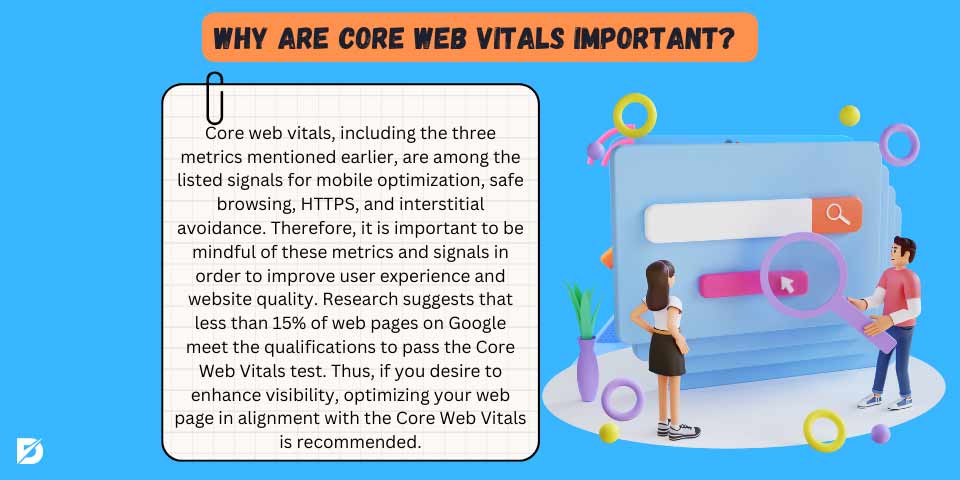
Why Are Core Web Vitals Important?
As it is known, Google has become the number one search engine for users who are looking for answers. So, Google’s giving place to your website for SERPs is the main goal for most web page owners. If you want to get higher rankings in SERPs and also increase the traffic to your website, core web vitals are the things you should be careful about. Look for the web design options.
There are five important search signals of Google for a web page experience. Core web vitals, with its three metrics that we mentioned above, is one of the signals on the list with mobile optimization, safe browsing, HTTPS, and interstitial avoidance. Thus, in order to increase user experience and the quality of your website, you need to be cautious about those metrics and signals. According to the research, less than 15% of the web pages on Google are qualified enough to pass the Core Web Vitals test. Hence, you should optimize your web page in line with the Core Web Vitals if you want to increase visibility.
Improving Core Web Vitals will give you an advantage against your rivals and competitors. So, in the following sections of our article, we will discuss Core Web Vitals metrics and how to use them to improve your website experience.
Core Web Vitals Metrics
I think now we have some grasp of the idea of what is Core Web Vitals. But what is also important in our guide is understanding Core Web Vitals metrics and how to benefit from them. Without losing time, let’s talk about the metrics and their importance.

Largest Contentful Paint (LCP)
Largest Contentful Paint (LCP) is one of the Core Web Vitals metrics that focus on measuring loading performance and user experience on websites. LCP specifically evaluates how quickly the largest content element within the viewport becomes visible to the user during the initial page load. This content element is often a significant visual element, such as an image, video, or text block.
LCP is crucial because it directly impacts the perceived loading speed of a web page. A fast LCP time means that users are more likely to see meaningful content quickly. Leading to a more positive user experience. On the other hand, a slow LCP time can lead to frustration and higher bounce rates, where users might leave the site before it fully loads.
Google’s recommended LCP target is under 2.5 seconds for a good user experience. However, striving for even faster loading times is ideal. Regularly monitoring and improving your website’s LCP performance can contribute to higher user satisfaction and potentially better search engine rankings.
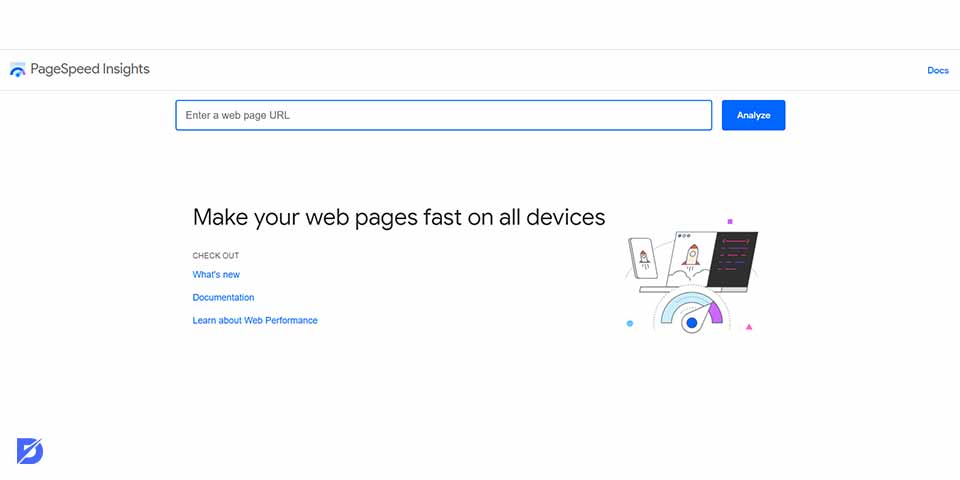
How to Measure LCP
Measuring the Largest Contentful Paint (LCP) involves evaluating the loading performance of a web page to determine how quickly the largest content element becomes visible to users. You can measure LCP using various tools and techniques we will mention in the following sections of our article. These are Google PageSpeed Insights or Lighthouse. But for now, let’s focus on the necessary steps you can follow to measure your page’s LCP Core Web Vitals. To measure LCP effectively, follow these general steps:
- Open the tool of your choice, such as Google PageSpeed Insights or Lighthouse.
- Enter the URL of the web page you want to test.
- Initiate the analysis or test.
- Review the generated report, paying specific attention to the LCP value and any recommendations for improvement.
- Follow the suggested optimizations to improve your LCP performance.

How to Improve LCP
To optimize for a better LCP Core Web Vitals score and improved user experience, website owners and developers should focus on a few key strategies:
- Optimize Images and Media: Large images and media files can significantly contribute to slow loading times. Compressing images and using modern image formats (like WebP) can help reduce file sizes while maintaining quality.
- Prioritize Loading Critical Resources: Ensure that essential resources, such as stylesheets and scripts required to render the main content, are loaded quickly. Consider techniques like lazy loading to defer loading non-critical resources.
- Leverage Browser Caching: Utilize browser caching to store frequently used resources on a user’s device. Reducing the need to fetch them each time a page is loaded.
- Content Delivery Networks (CDNs): CDNs distribute website content across multiple servers, often located closer to users, reducing the physical distance data needs to travel and improving loading times.
- Minimize Server Response Times: Server response time affects how quickly a browser can receive the first byte of data from the server. Optimizing server configurations and using efficient hosting solutions can help reduce this time.
- Use Performance Budgets: Set performance budgets for your website to ensure that each page’s content doesn’t exceed a certain size. This helps maintain optimal loading times.
- Mobile-Friendly Design: Designing websites with a mobile-first approach can lead to faster loading times on mobile devices, where LCP is equally essential.
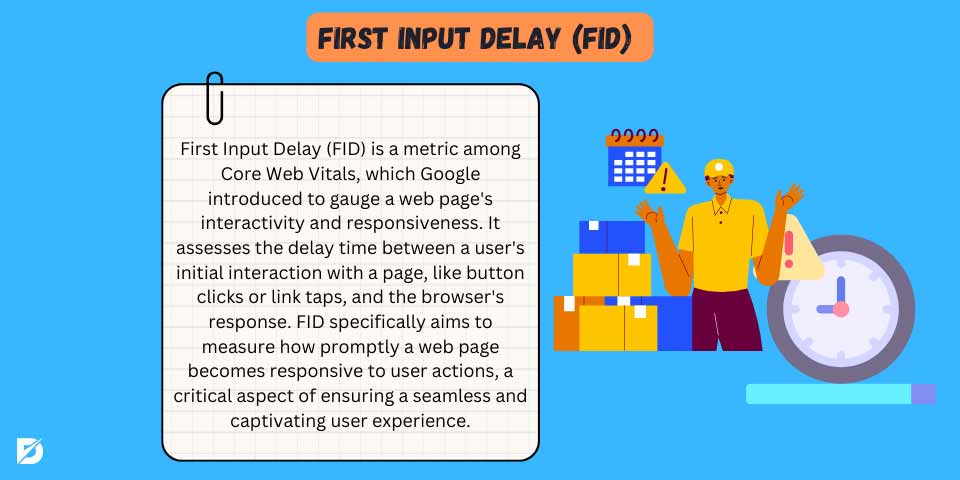
First Input Delay (FID)
First Input Delay (FID) is one of the Core Web Vitals metrics introduced by Google to measure the interactivity and responsiveness of a web page. It evaluates the time delay between a user’s first interaction with a page (such as clicking a button or tapping on a link) and the browser’s response. FID focuses on quantifying how quickly a web page becomes responsive to user actions, which is crucial for delivering a smooth and engaging user experience.
FID is essential because it reflects how users perceive the responsiveness of a website. When users interact with a web page, they expect immediate feedback. If there’s a noticeable delay between their action and the page’s response, it can lead to frustration, confusion, and an overall negative user experience. Websites with fast FID times are more likely to retain and encourage users to engage further.
Google recommends aiming for an FID of 100 milliseconds or less for a good user experience. An FID of 100 to 300 milliseconds is considered to need improvement, and an FID over 300 milliseconds is considered poor.
Monitoring and addressing FID issues can lead to better user engagement and satisfaction on your website. Regularly testing and optimizing for FID, along with other Core Web Vitals metrics, can contribute to improved overall web performance and search engine rankings.
How to Measure FID
It’s important to note that FID is a user-centric metric and requires actual user interactions to be measured accurately. Therefore, testing FID often involves simulations or real user data collected from actual website visitors.
Regularly monitoring FID and addressing any issues can provide a more responsive and engaging user experience. Potentially leading to better search engine rankings and user satisfaction. Here are the steps you can follow to measure FID for your web page:
- Open the tool of your choice, such as Google PageSpeed Insights or Lighthouse.
- Enter the URL of the web page you want to test.
- Initiate the analysis or test.
- Review the generated report, paying specific attention to the FID value and any recommendations for improvement.
- Follow the suggested optimizations to improve your FID performance.
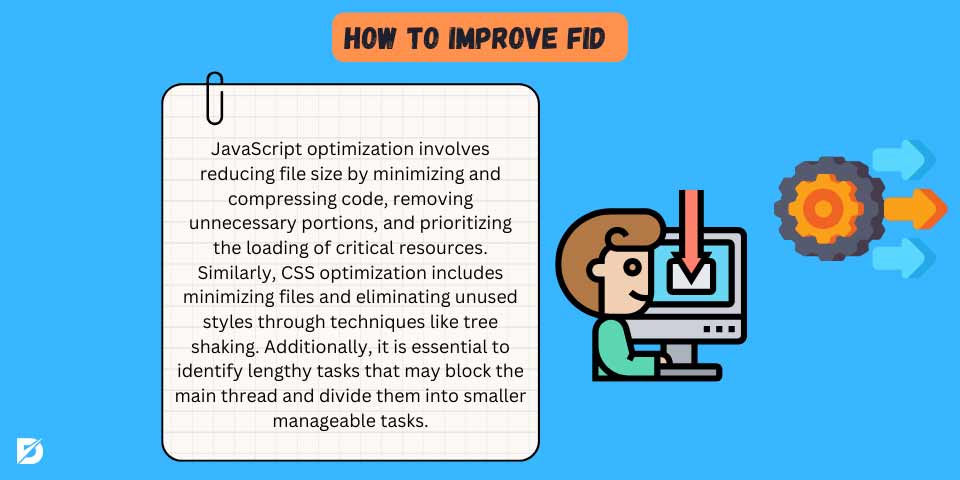
How to Improve FID
Enhancing FID for a smooth user experience is crucial for the websites. Here are some things you can do to improve Core Web Vitals for your web page:
- Optimize JavaScript: You can minimize and compress JavaScript files to reduce size. Also, you can remove unnecessary or unused JavaScript code. To do that, you may consider asynchronous loading of scripts to prevent blocking the main thread.
- Prioritize Critical Resources: Your web page needs to load critical resources first to ensure that the user can interact with the page sooner. You can use techniques like preloading and resource hints to fetch necessary resources in advance.
- Lazy Loading: You can implement lazy loading for images and other non-essential content below the fold. This prevents resources from loading until they are actually needed, reducing initial page load times.
- Optimize CSS: You can minimize CSS files and use techniques like tree shaking to remove unused styles. You may want to avoid render-blocking CSS that can delay the page’s interactivity.
- Split Long Tasks: You may identify long tasks that can block the main thread and split them into smaller tasks. This prevents the main thread from being occupied for an extended period.
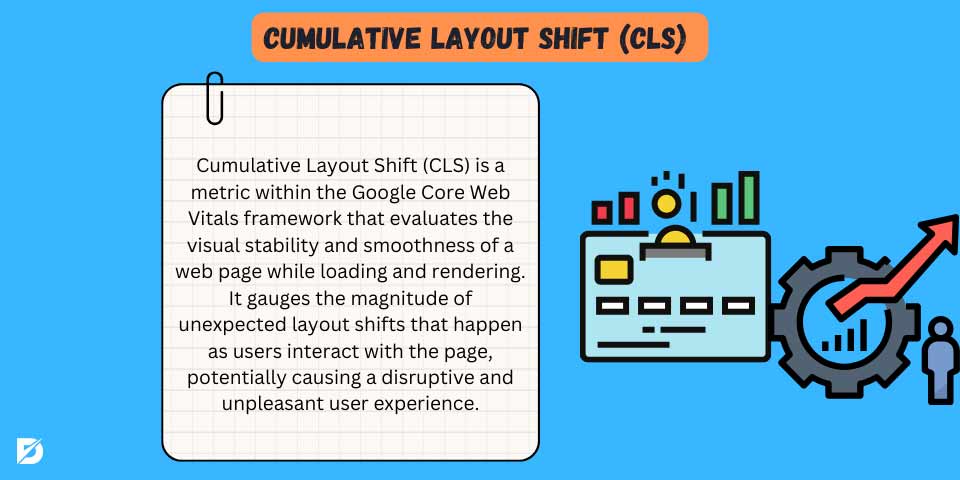
Cumulative Layout Shift (CLS)
Cumulative Layout Shift (CLS) is one of the Google Core Web Vitals metrics to measure a web page’s visual stability and smoothness during its loading and rendering process. It assesses the extent of unexpected layout shifts that occur as users interact with the page. This can lead to a disruptive and frustrating user experience.
Layout shifts happen when page elements move unexpectedly, often due to asynchronous loading of resources or delayed rendering of content. For example, if a user is about to click a button and suddenly an image loads above the button, causing it to move, this results in a poor user experience. CLS quantifies these shifts by calculating the impact fraction and distance fraction of layout changes.
CLS is measured on a scale from 0 to 1, where a lower score indicates better visual stability. It considers the sum of layout shift scores that occur during a user’s session. Two factors determine the CLS score:
- Impact Fraction: The proportion of the viewport that is affected by layout shifts.
- Distance Fraction: The amount by which the shifted elements move relative to the viewport size.
According to those factors, Google recommends aiming for a CLS score of 0.1 or lower for a good user experience. Websites with lower CLS scores are more likely to provide a smoother and more visually stable experience. Users are less likely to be disoriented by unexpected layout changes.
How to Measure CLS
The steps you need to follow to measure CLS are similar to the other Core Web Vitals metrics mentioned above -LCP and FID. The important thing is to know what tool to use to measure the metrics. Hence, in the following sections of our article, we will discuss what tools you can use to measure those metrics.
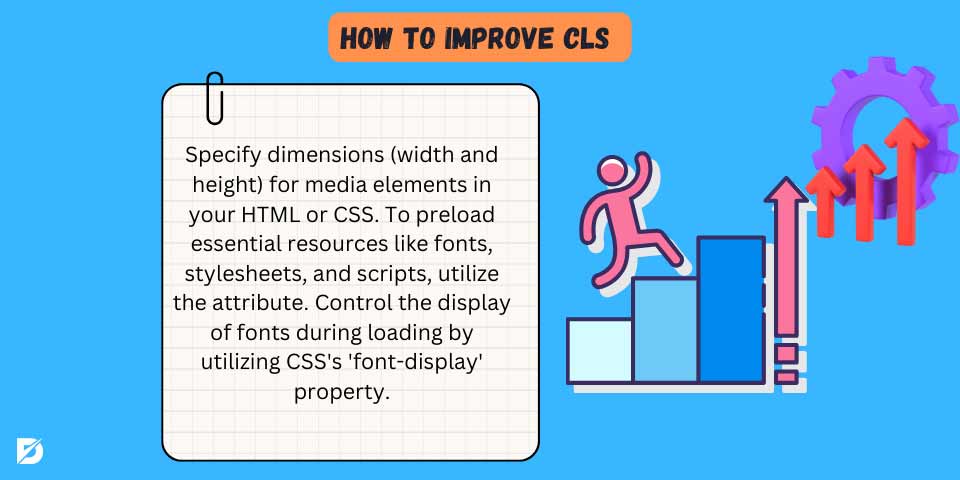
How to Improve CLS
By implementing the strategies below and continually optimizing your web page’s layout and resource loading, you can significantly improve CLS and provide users with a smoother, more visually stable experience. Here are the strategies you can implement for better CLS Core Web Vitals:
- Set Dimensions for Media: In your HTML or CSS, you can specify dimensions (width and height) for images, videos, and other media elements. This reserves space for the media, preventing content from jumping around when it loads.
- Preload Critical Resources: You may use the <link rel=”preload”> attribute to preload important resources such as fonts, stylesheets, and scripts. This ensures that resources are loaded early and reduces the chances of layout shifts.
- Avoid Dynamically Injected Content: If you’re loading content dynamically (e.g., ads or iframes), ensure that you reserve space for the content before it’s loaded to prevent layout shifts.
- Optimize Font Loading: You can use CSS’s ‘font-display’ property to control how fonts are displayed during loading. The “swap” value can prevent text layout shifts caused by delayed font loading.
Other Performance Metrics
Even though we mentioned metrics, which are currently the most essential Core Web Vitals metrics, other performance metrics are significant. In order to improve Core Web Vitals for your web page, you may also want to benefit from other metrics. These are Total Blocking Time, Speed Index, and so on. In this section of our article, we will discuss what are the other performance metrics of Core Web Vitals that can increase user experience.
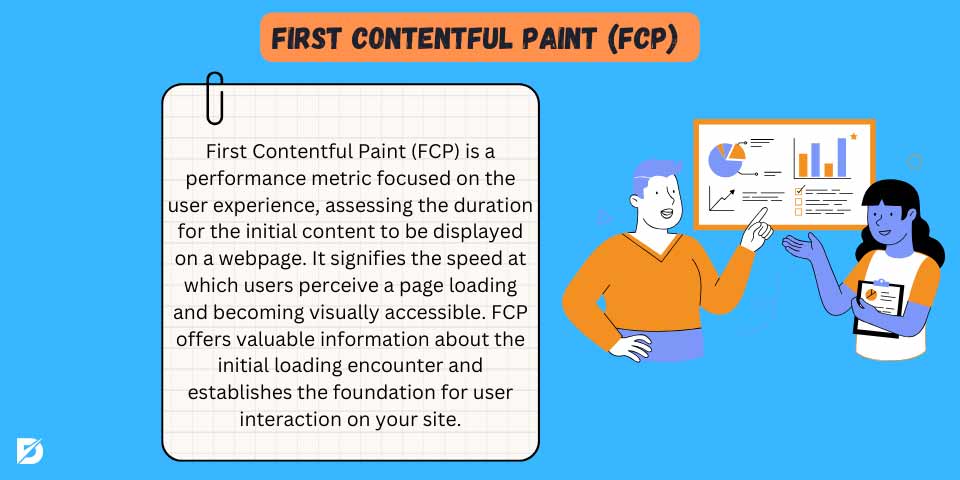
First Contentful Paint (FCP)
First Contentful Paint (FCP) is a user-centric performance metric that measures the time it takes for the first piece of content to be rendered on a web page. It indicates how quickly users perceive a page loading and becoming visually usable. FCP provides insights into the initial loading experience and sets the baseline for user engagement on your website. Google suggests aiming for an FCP of less than 1 second for a good user experience.
Interaction to Next Paint (INP)
Interaction to Next Paint (INP) stands as a metric within the Google Search Console Core Web Vitals report. Designed to assess the user experience of a webpage. This metric checks the time span between consecutive user interactions on the page and highlights the duration of the lengthiest interaction.
According to Google, the INP metric tracks the delay in user interactions with the webpage. It provides a singular value encompassing instances where most interactions occurred swiftly if not all. A lower INP value signifies that the page consistently exhibited rapid responses to a substantial portion, if not all, of user interactions. Regarding the INP benchmarks that Google employs to categorize performance:
- Good: Below 200 milliseconds.
- Needs Improvement: Between 200 and 500 milliseconds.
- Bad: Exceeding 500 milliseconds.
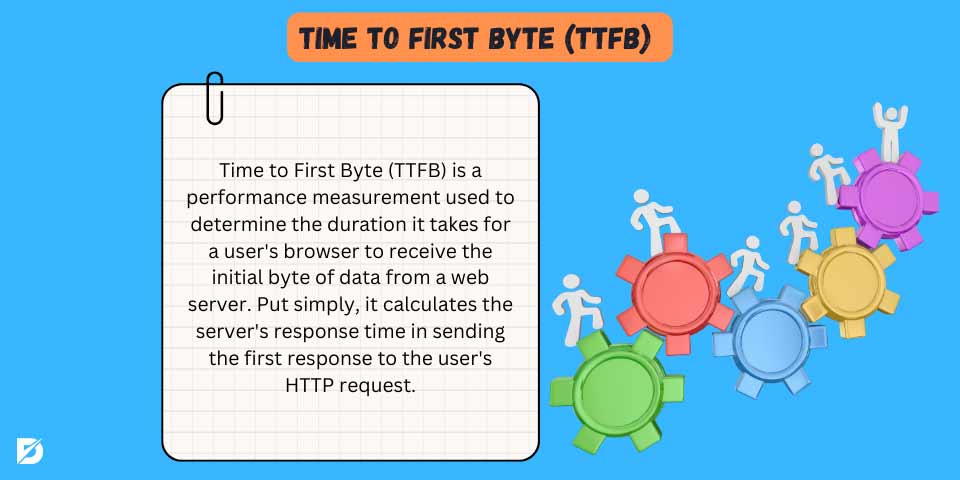
Time to First Byte (TTFB)
Time to First Byte (TTFB) is a web performance metric that measures the time it takes for a user’s browser to receive the first byte of data from a web server. In other words, it calculates the time the server takes to send the initial response to a user’s HTTP request.
TTFB is influenced by both network latency (the time it takes for data to travel between the user’s device and the server) and the server’s processing capabilities. A fast TTFB contributes to a faster-perceived loading time for users, as it indicates that the server is responsive and delivers content promptly. TTFB can also impact search engine optimization (SEO), as search engines consider site speed a ranking factor. A faster TTFB can contribute to improved search engine rankings.
Total Blocking Time (TBT)
Total Blocking Time (TBT) is a performance metric that measures the time a web page’s main thread is blocked and unresponsive to user input. It is closely related to user interactivity and responsiveness. It is particularly relevant to the concept of “blocking scripts” that can delay a user’s ability to interact with a page.
TBT is often used in conjunction with the First Input Delay (FID) metric to provide a comprehensive understanding of how a web page’s interactivity impacts the user experience. Blocking scripts can delay a user’s ability to interact with a page, leading to frustration and a less engaging user experience. TBT aims to quantify this delay.
TBT is measured within a specific timeframe, often the window between First Contentful Paint (FCP) and Time to Interactive (TTI). It captures the period when content starts rendering to the point when the page becomes fully interactive. Google recommends aiming for a TBT of 300 milliseconds or less for a good user experience.
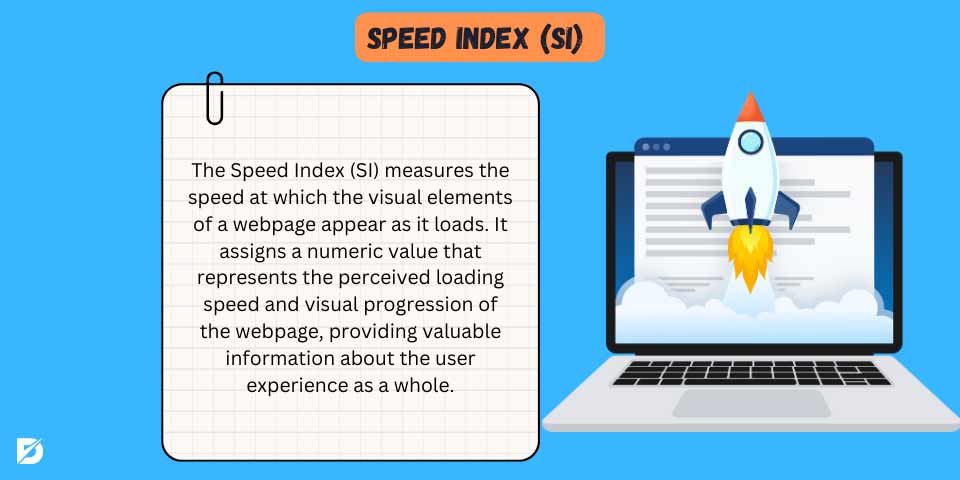
Speed Index (SI)
Speed Index (SI) quantifies how quickly the visual content of a web page becomes fully visible during its loading process. It provides a numerical value that reflects a web page’s perceived loading speed and visual progress, offering insights into the overall user experience.
Unlike metrics that measure specific events (e.g., First Contentful Paint, Largest Contentful Paint), Speed Index provides a more holistic view of a web page’s loading experience. It considers the progression of all visible content, considering when and how each element becomes visible. Speed Index Core Web Vitals reflects how quickly a user can understand and interact with the content as it becomes visible. Pages with lower Speed Index scores are perceived to load faster and are likely to provide a more positive user experience.
Core Web Vitals and SEO
Core Web Vitals are a set of specific web performance metrics introduced by Google that focus on user experience. They include Largest Contentful Paint (LCP), First Input Delay (FID), and Cumulative Layout Shift (CLS). LCP measures loading speed, FID evaluates interactivity, and CLS assesses visual stability. As mentioned above, these are important signals and metrics for making a web page user-friendly and more accessible.
Regarding SEO, Google has integrated Core Web Vitals into its search ranking algorithm. This means that the user experience factors measured by these metrics play a role in determining how well a website ranks in search engine results. Websites that provide a better user experience by optimizing Core Web Vitals are more likely to rank higher in search results. Leading to increased organic visibility and traffic. Prioritizing these Core Web Vitals metrics not only aligns with Google’s emphasis on user satisfaction but also contributes to overall site performance and user engagement, which are key factors in successful SEO strategies. Now, we will discuss the impact of Core Web Vitals and how to incorporate those into your SEO strategy. Learn how to improve SEO.
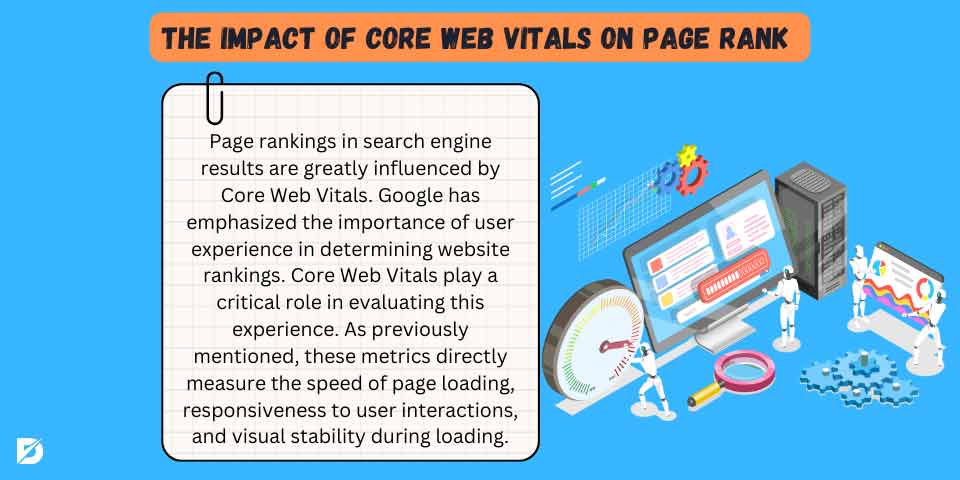
The Impact of Core Web Vitals on Page Rank
Core Web Vitals significantly impact page rank within search engine results. Google has made it clear that user experience is a priority when it comes to ranking websites. Core Web Vitals are a key component of assessing that experience. These metrics, as mentioned before, directly measure how fast a page loads, how responsive it is to user interactions, and how visually stable it remains during loading. Check out a rank checker tool.
Websites that provide a smoother, more user-friendly experience by optimizing their Core Web Vitals are more likely to rank higher in search engine results. While other factors like content relevance and authority are still important, a positive user experience, as reflected by these metrics, can give your website a competitive advantage in search rankings.
Google introduced Core Web Vitals as part of its broader initiative to improve the web for users, and integrating these metrics into its ranking algorithm aligns with that goal. As a result, SEO efforts should include a focus on optimizing Core Web Vitals alongside other traditional ranking factors to ensure an approach that benefits both users and search visibility. Learn how to improve SEO with user experience.
Incorporating Core Web Vitals into Your SEO Strategy
Incorporating Core Web Vitals into your SEO strategy is essential for enhancing user experience. Also, improving search rankings and overall site performance. Here’s how to do it effectively:

Audit and Analyze
You can begin by assessing your website’s current Core Web Vitals performance using tools like Google PageSpeed Insights, Lighthouse, or Web Vitals Extension. You must identify areas needing improvement, such as slow-loading elements, delayed interactivity, or layout shifts.
Optimize Loading Speed (LCP)
You need to optimize server response times and leverage content delivery networks (CDNs) to speed up content delivery. You can compress images and use next-gen image formats to reduce file sizes. Moreover, you can implement lazy loading for images and videos below the fold.
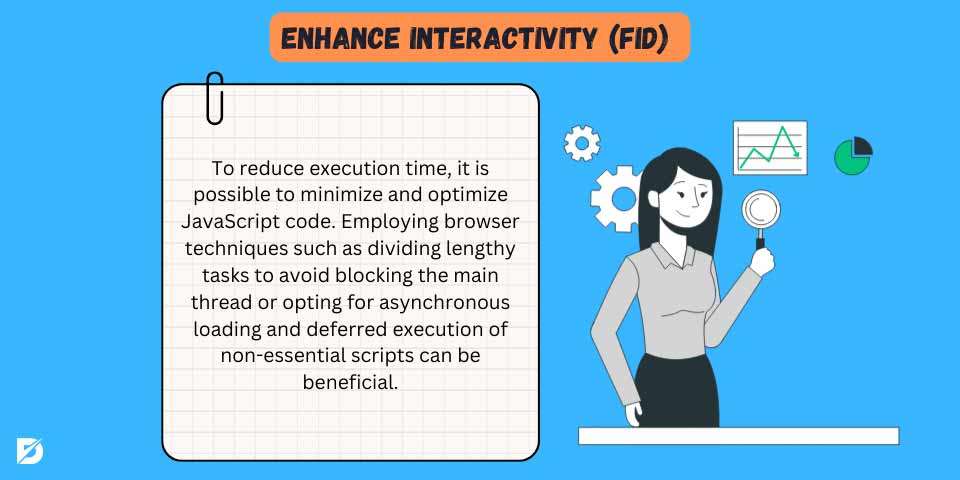
Enhance Interactivity (FID)
You can minimize and optimize JavaScript code to reduce execution time. You may use browser techniques like splitting long tasks to prevent the main thread from blocking or opt for asynchronous loading and deferred execution for non-essential scripts.
Ensure Visual Stability (CLS)
You might set dimensions for media elements to prevent layout shifts. You can use the “preload” attribute for resources that might affect the layout. Also, you can avoid adding content above existing content that could push it down.

Content and SEO Integration
You need to balance Core Web Vitals optimization with other SEO efforts like content relevance and backlink building. But still, quality content remains important, so maintain a strong content strategy alongside performance improvements. Check out some SEO tools!
Mobile Optimization
To support Core Web Vitals improvements, you can review your site’s technical aspects. Such as server configurations, caching, and mobile optimization. However, you need to ensure your website is fully responsive and optimized for mobile devices. Mobile performance is a key aspect of Core Web Vitals.
Tools to Measure Core Web Vitals
In the pursuit of a better user experience and improved search rankings, webmasters and developers rely on various tools to measure and assess Core Web Vitals. These metrics provide insights into key aspects of a website’s performance, such as loading speed, interactivity, and visual stability. As we mentioned in our previous sections of the article, there are some specific tools to measure Core Web Vitals to enhance your web page experience. By using specialized tools, website owners can gain a comprehensive understanding of how their sites perform in terms of these vital user-centric metrics. In this section, we’ll explore some of the prominent tools available, helping web professionals optimize their websites and create more seamless and engaging user experiences.

Google Search Console
Google Search Console (formerly Google Webmaster Tools) is a free web service provided by Google that offers webmasters, site owners, and SEO professionals valuable insights. It comes with tools to monitor, manage, and improve the presence of their websites in Google’s search results. It serves as a communication bridge between website administrators and Google’s search engine.
Provides detailed data on how your website appears in Google search results. You can see metrics like clicks, impressions, click-through rates (CTR), and average position for specific keywords and pages. Here’s how Google Search Console can be used specifically for Core Web Vitals measurement:
- Core Web Vitals Report: Google Search Console offers a dedicated report that provides insights into how your website performs in terms of LCP, FID, and CLS. It displays data for both mobile and desktop views, highlighting URLs with good, need improvement, or poor performance. This report enables you to identify specific pages that require attention and optimization.
- URL Inspection Tool: The URL Inspection Tool within Google Search Console provides detailed information about individual URLs, including metrics. You can assess whether a particular URL meets the thresholds for a good user experience and identify any performance issues.
- Mobile Usability Report: While not exclusively for Core Web Vitals, the Mobile Usability Report in Google Search Console is closely related. It helps you identify mobile usability issues that might have an impact. Such as text that’s too small to read or clickable elements that are too close together. Use a mobile-friendly test tool.
- Fixing Issues: Google Search Console helps you identify and fix issues that impact Core Web Vitals, such as slow-loading resources or layout shifts. Addressing these issues improves your website’s overall user experience, positively influencing search rankings.

PageSpeed Insights
Google PageSpeed Insights is a web performance analysis tool provided by Google that helps you evaluate and optimize the speed and user experience of your web pages. It provides insights and suggestions to improve loading times, interactivity, and overall user engagement. PageSpeed Insights is designed to help website owners, developers, and SEO professionals enhance their websites’ performance to meet modern user expectations and search engine ranking criteria. Check page speed and SEO relation.
Google PageSpeed Insights is an invaluable tool for evaluating and improving Core Web Vitals. These are user-centric metrics that measure critical aspects of web page performance. Here’s how PageSpeed Insights can assist in optimizing Core Web Vitals:
- Core Web Vitals Insights: PageSpeed Insights provides insights related explicitly to Core Web Vitals—Largest Contentful Paint (LCP), First Input Delay (FID), and Cumulative Layout Shift (CLS). It measures these metrics and offers a comprehensive view of how well your pages perform regarding loading speed, interactivity, and visual stability.
- Real-World Data: The tool uses both lab data (simulated performance tests) and field data (actual user experiences) to provide a holistic understanding of your pages’ performance. This combination helps you identify issues that users might encounter across different devices and network conditions.
- Metric Breakdown: PageSpeed Insights breaks down each Core Web Vital metric, showing the specific elements contributing to its performance. This breakdown allows you to pinpoint the areas that need improvement.
- Score Interpretation: PageSpeed Insights assigns scores to your pages for mobile and desktop views. These scores reflect how well your pages adhere to Core Web Vitals thresholds. The tool highlights areas that need attention and categorizes pages as “Fast,” “Average,” or “Slow.”

Core Web Vitals Chrome Extension
The Core Web Vitals Chrome Extension is a powerful tool designed to help web developers, site owners, and SEO professionals assess the Core Web Vitals metrics directly within their web browsers. This extension facilitates real-time evaluation of a web page’s performance, allowing users to identify issues and opportunities for improvement related to these user-centric performance metrics.
This extension offers an on-the-fly evaluation of Core Web Vitals metrics for the currently loaded web page. This provides immediate insights into how the page performs regarding loading speed, interactivity, and visual stability. The extension displays visual indicators for each Core Web Vitals metric. Such as highlighting the point of the Largest Contentful Paint or simulating user interactions to measure the First Input Delay. These visual cues help users quickly grasp how different elements contribute to the user experience.

Lighthouse
Lighthouse is an open-source tool developed by Google that helps developers, webmasters, and SEO professionals assess and improve the quality and performance of web pages. It’s designed to measure a range of web performance metrics. Including Core Web Vitals—Largest Contentful Paint (LCP), First Input Delay (FID), and Cumulative Layout Shift (CLS). Lighthouse provides valuable insights into a webpage’s loading speed, interactivity, and visual stability, offering actionable recommendations for optimization. Learn how to use Lighthouse. Here are some key features:
- Comprehensive Audit: Lighthouse conducts a comprehensive audit of web pages, evaluating various performance aspects. It provides a holistic view of Core Web Vitals metrics along with other key metrics related to accessibility, SEO, and best practices.
- Core Web Vitals Emphasis: Lighthouse significantly emphasizes Core Web Vitals metrics. It reports on the performance of LCP, FID, and CLS individually. Allowing users to understand how well their pages meet these user-centric performance thresholds.
- Score and Metrics Breakdown: Lighthouse assigns a performance score to web pages, which reflects their overall performance. It also provides detailed breakdowns of specific metrics. Including Core Web Vitals, explaining how these metrics contribute to the overall score.
- Lab Data and Field Data: Similar to PageSpeed Insights, Lighthouse provides both lab data (simulated performance metrics based on controlled tests) and field data (real-world performance metrics from actual user experiences). This combination helps users understand the overall performance landscape.
- Core Web Vitals Budgets: Lighthouse allows users to set performance budgets for Core Web Vitals metrics. This feature enables proactive metrics monitoring and ensures optimizations are within desired thresholds.
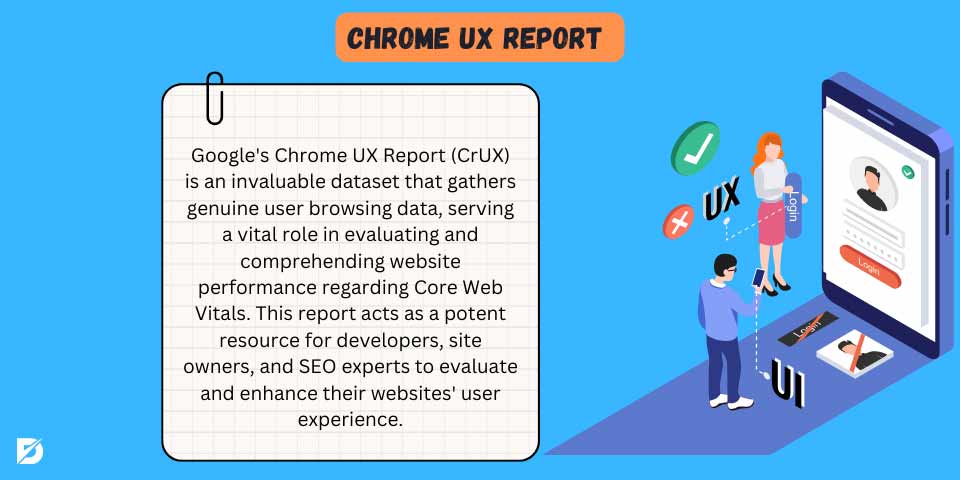
Chrome UX Report
The Chrome UX Report (CrUX) is a valuable dataset provided by Google that collects real-world performance data from actual users’ browsing experiences. It plays a crucial role in evaluating and understanding how websites perform regarding Core Web Vitals. The Chrome UX Report is a powerful tool for developers, site owners, and SEO professionals to assess and improve the user experience of their websites.
The Chrome UX Report provides insights into how real users experience websites. Offering data on various performance metrics, including Core Web Vitals. It allows developers and site owners to gauge the actual user experience across diverse devices, network conditions, and geographic locations. Moreover, Within the Chrome UX Report, you can access field data related to Core Web Vitals. This data includes percentiles for LCP, FID, and CLS, giving you a clear picture of how your website performs for different user segments. Don’t forget to check the free SEO tools here.
The aggregated data in the Chrome UX Report allows you to compare your website’s Core Web Vitals performance to broader industry benchmarks. This enables you to set realistic goals for optimization and align your site with best practices. Lastly, by regularly monitoring the Chrome UX Report, you can track the impact of your Core Web Vitals optimizations over time. This enables you to ensure consistent user experiences and measure the success of your performance improvements.
Plug-Ins
A plugin, also spelled as “plug-in,” is a piece of software that adds specific features or functions to an existing computer program or application. It extends the capabilities of the host program without requiring users to modify the program’s core code. Plugins are commonly used in various software applications, including web browsers, content management systems (CMS), image editing software, audio and video players, and more. Today, we will see the applicable plug-ins to improve core web vitals.
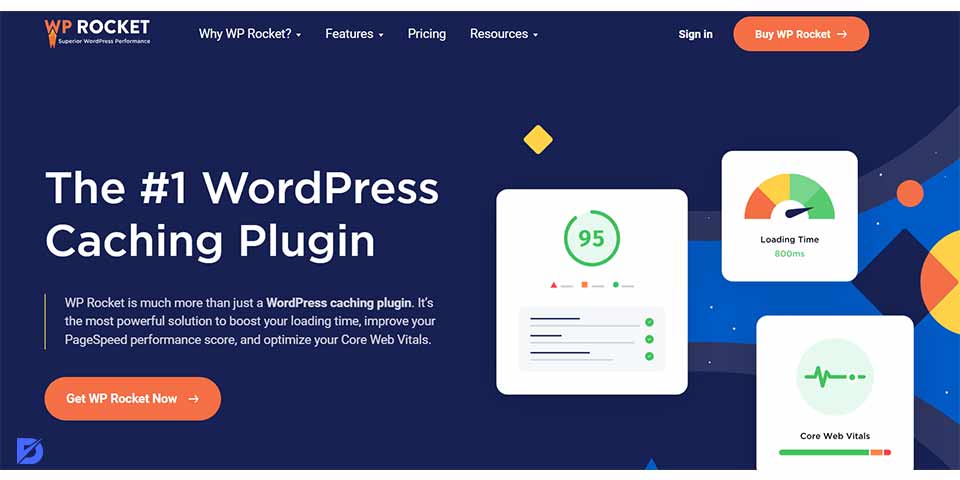
WP Rocket
WP Rocket is a popular WordPress caching plugin that helps improve the speed and performance of WordPress websites. While WP Rocket does not directly measure Core Web Vitals metrics, it can still significantly optimize your website’s performance. Doing this by indirectly contributing to improving Core Web Vitals.
WP Rocket offers various caching features, such as page caching, browser caching, and GZIP compression. These help reduce server response times and overall page load times, positively affecting LCP and FID. Also, you can activate lazy loading for images and videos with WP Rocket. Lazy loading ensures that media elements load only when they’re visible in the user’s viewport. Contributing to improved LCP and CLS. Lastly, WP Rocket allows you to defer the loading of JavaScript files. This can help improve FID by prioritizing the loading of critical resources first.
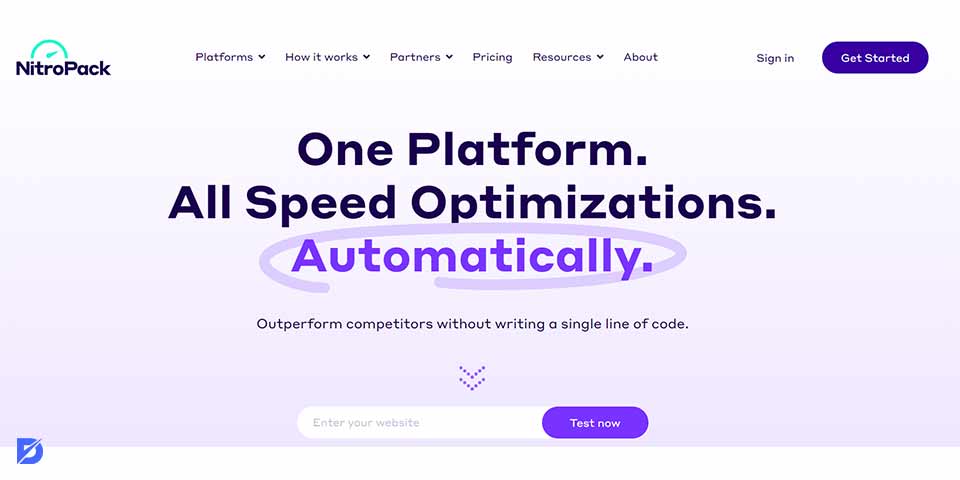
NitroPack
NitroPack is a performance optimization service for websites, specifically focusing on improving page loading times and user experience. While NitroPack may have introduced new features or changes since then, we provide you general guidance on how you might use NitroPack to measure and improve Core Web Vitals metrics.
NitroPack may offer performance testing tools or integration with third-party tools. You can look for options to test your website’s performance before and after optimization. This could include measuring LCP, FID, and CLS, although direct measurement of Core Web Vitals may depend on NitroPack’s features. Also, NitroPack likely employs various caching mechanisms and optimizations to improve page loading times. These optimizations can indirectly have an impact by enhancing overall page speed.
In order to do image optimization, NitroPack might optimize images to reduce their size without sacrificing quality. Optimized images can contribute to improved LCP and CLS. Moreover, you can check if NitroPack minifies and compresses CSS and JavaScript files. Smaller file sizes can lead to faster loading times, positively affecting Core Web Vitals.
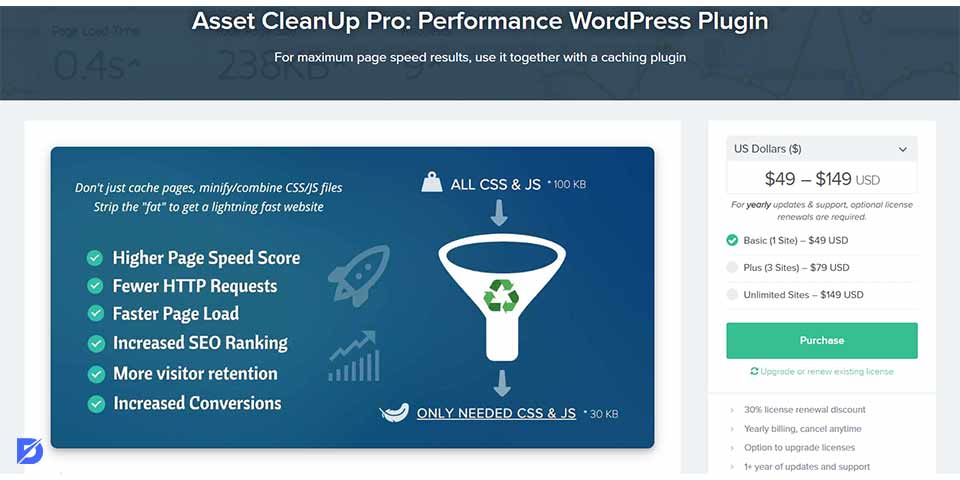
Asset Clean Up
Asset Clean Up is a WordPress plugin designed to optimize your website’s performance by selectively disabling or removing unnecessary CSS and JavaScript files on specific pages. While Asset Clean Up primarily focuses on reducing the number of assets loaded on a page, which can indirectly impact Core Web Vitals, it may not provide direct measurements. However, optimizing your assets can positively affect these metrics. Do a website speed test now!
Asset CleanUp provides options to analyze specific pages on your website and identify the loaded CSS and JavaScript assets. This can help you determine which assets might be unnecessary and impact performance. You can review the analysis results and selectively disable CSS and JavaScript files that are not required for specific pages. Removing unnecessary assets can help reduce the page load size. Also, to improve loading speed, contributing to better LCP and CLS scores.
Mastering Core Web Vitals and Elevating Website Performance
Optimizing Core Web Vitals has emerged as a critical endeavor in order to enhance user experience. These user-centric performance metrics—Largest Contentful Paint, First Input Delay, and Cumulative Layout Shift—have taken center stage in enhancing website speed, interactivity, and visual stability. As we navigate this digital terrain, tools like Asset Clean Up, NitroPack, and WP Rocket, and performance analysis tools such as Lighthouse and Chrome UX Report offer valuable assistance. By embracing these tools, website owners, developers, and SEO professionals can methodically measure, evaluate, and refine their websites. They can ensure they meet the demands of modern users and search engine ranking criteria.
The pursuit of Core Web Vitals optimization emphasizes the industry’s commitment to crafting online experiences that are not only smooth and efficient but also profoundly user-centric. In this journey, the intersection of technology and user satisfaction paves the way for a web ecosystem that thrives on performance excellence.
Frequently Asked Questions About
Core Web Vitals are essential performance metrics introduced by Google to measure and enhance the user experience of webpages. They focus on loading speed, interactivity, and visual stability.
Core Web Vitals are now a ranking factor in Google’s search algorithm. Websites that provide better user experiences by meeting the recommended thresholds for LCP, FID, and CLS tend to rank higher in search results. Google aims to prioritize websites that load quickly, respond promptly, and maintain visual stability, all contributing to a positive user experience.
Largest Contentful Paint (LCP) measures the time it takes for the largest visible content element to appear on a page. First Input Delay (FID) measures the delay between a user’s interaction and the browser’s response. Cumulative Layout Shift (CLS) quantifies unexpected layout shifts during page loading.
A good score for Core Web Vitals means meeting the recommended thresholds set by Google. LCP under 2.5 seconds, FID under 100 milliseconds, and CLS under 0.1. Aim for these scores to ensure a positive user experience and potential SEO benefits.
You can use tools and various website auditing plugins to measure your website’s Core Web Vitals.
Tools like Google PageSpeed Insights, Lighthouse, Chrome UX Report, and website optimization plugins (e.g., WP Rocket) can help you measure and improve Core Web Vitals. Additionally, Google Search Console provides insights and recommendations.
Regular monitoring is recommended, especially when making changes to your website. Consider checking Core Web Vitals before and after optimizations to gauge improvements. Also, keep an eye on Google’s updates and recommendations.
Common issues include slow server responses, large unoptimized images, render-blocking resources, excessive JavaScript execution, and elements causing layout shifts. These can impact LCP, FID, and CLS negatively.
Core Web Vitals are expected to undergo further development, with Google introducing a new experimental metric named Interaction to Next Paint in 2022. This metric measures the duration between a user’s interaction with a webpage and the subsequent update of the page’s content. So, it is important to be aware of the ongoing trends.





No comments to show.